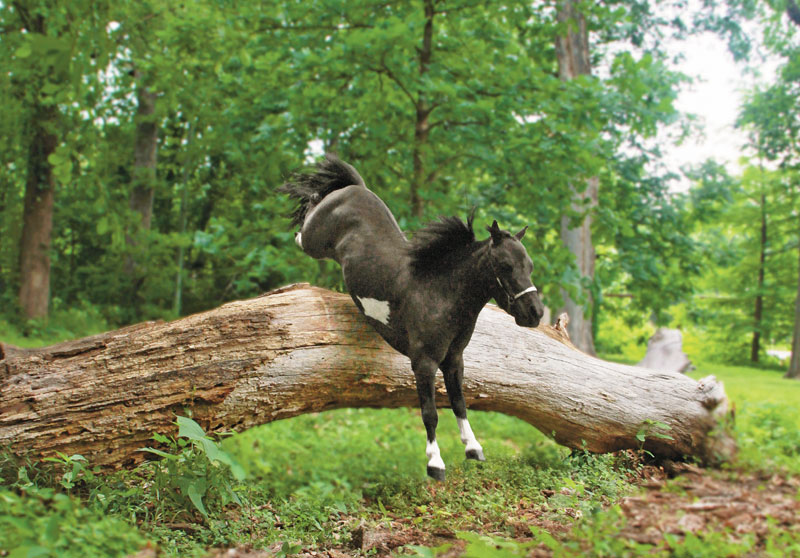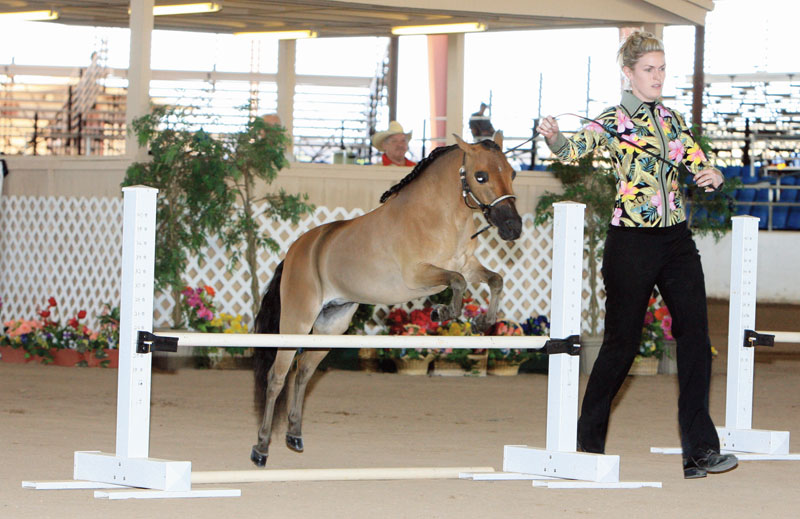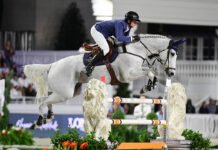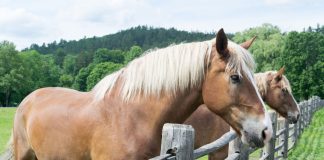The Miniature Horse embodies the “aww” factor with its cute little frame, but don’t let its size fool you. This diminutive horse also has skills. In fact, a Mini can accomplish just about anything its larger equine cousin can, minus the saddle. You can even compete your Mini in in-hand jumping competitions similar to the under-saddle sports. Teaching your Mini to jump is based on the same foundation as well.

Photo courtesy AMHA
Basic Handling
Before her Minis ever approach a jump, Sweatt makes sure they respect her space and can move off her body language. “The handler is on the left side, slightly in front of the horse’s shoulder,” she says. “Practicing lots of transitions between the walk, trot and [halt] while leading your horse will put you ahead of the game when it comes time to begin training to jump.”
Brooke Glosser, a past president of the American Miniature Horse Youth Association, trains and shows Minis in hunters. She agrees that establishing manners in Minis is the first step to teaching them to jump. “It’s always best to develop a relationship with your horse,” she says. “He needs to go with your motion at the same pace. Teach him voice commands for each gait, as well as ‘easy,’ ‘slow,’ and ‘whoa.’”
Sweatt suggests starting your Mini’s training by teaching him to pivot, a helpful skill for off-side (right) turns in the hunter/jumper arena. Apply direct pressure to the lead rope and exaggerate your body language by taking a large step with your right foot and tilting your shoulders. Use verbal cues, like ‘pivot’ or ‘over,’ as well. “Immediately stop and release the pressure when your horse gives the slightest response,” says Sweatt. “If more pressure is needed to get him to move away, push on his left shoulder with your right hand.”
Eventually you will need to work on refining your communication through body language because exaggerated aids and audible voice commands will be marked down in the show-ring.
Introducing Jumps
Only when Sweatt and her Minis have established solid communication skills will she introduce them to jumping. She starts by asking them to free-jump over ground poles in a round pen using a longe whip to direct them. In addition to honing their focus and reaction to Sweatt’s body language, this exercise helps them learn to gauge distances and develop the appropriate stride, rhythm and cadence on their own.
“Since Miniatures aren’t ridden and don’t have the advantage of a rider’s leg or hand aids to guide them, they will ultimately need to find the right takeoff spot on their own,” says Sweatt. “This is quite a challenge, but with repetition, a lot of Miniatures can be taught to jump with surprisingly good form. Have [your horse] walk and then trot over ground poles spaced to the length of his stride. Eventually, add standards on either side of the poles.”
Gradually, when they are ready, Sweatt guides her Minis over low cross-rails in a halter and lead rope to build their confidence. “Cross-rails starting at 6 to 8 inches—with a ground pole in front of each—encourage a horse to track to the center of the jump.”
Moving Up
The next step is to introduce a line of jumps and slowly raise the height in 2-inch increments. When her Minis can jump 24-inch verticals correctly and confidently, Sweatt starts incorporating wider fences, like rolltops and walls. “It’s important to not rush the process,” she says. “Having a polished hunter/jumper doesn’t take weeks but many months, and sometimes years, to create.”
Lisa Caldwell, American Shetland Pony Club/American Miniature Horse Registry breed promotion chairperson and owner of Ozark Mountain Miniature Tack & Equine Supplies, also stresses the importance of an incremental training program. “They must have the basics before you start them with fancy jumps,” she explains. “We work [our Minis] in a large round pen and teach them to longe, then begin with poles and proceed to small, low pole jumps. Once they are comfortable with the pole jumps, we start adding width and decorations.” Caldwell notes that Minis usually either love or hate to jump, and it can be difficult to train one that doesn’t have the desire to do it.
Glosser adds that timing, praise and how you start and end your sessions are also part of a smooth, successful training process. “Always set up properly, giving your horse plenty of room to prepare for a jump,” she says. “End your session on a positive note, even if it means lowering the pole, and start each new session with an easy jump to warm up and gain your horse’s confidence.”

Miniature Horses can compete in in-hand hunter and jumper classes that are judged like the under-saddle sports. Photo courtesy AMHA
Additional Activities
If jumping isn’t your thing, there are many other in-hand activities to choose from, such as showmanship, obstacle (like a ridden trail class) and costume classes. And driving is one of the most popular Miniature Horse sports.
“[Minis] are intelligent and athletic, enjoy having a job to do, and are eager to please,” says Sweatt. “When I’m showing, it’s not unusual to compete with the same horse in halter conformation, halter obstacle, hunters and driving classes—all in the same day!”
Don’t have the competitive edge? You can still enjoy these activities at home, or share the joys of owning Minis with others. “Lots of Mini owners don’t care for the show scene, but they enjoy the companionship of their horses in a myriad of ways,” says Sweatt. “In-hand activities such as parades and visiting schools, hospitals and nursing homes are rewarding endeavors for all involved.”
“Their willingness to perform is just amazing, whether it’s a jumping competition or a therapy session in a nursing home,” adds Melissa Powell, editor of the American Miniature Horse Association’s Miniature Horse World Magazine. “Minis are just great companions, no matter the reason. I never tire of hearing how they have touched or changed someone’s life.”
Visit the American Miniature Horse Association (www.amha.org) and the American Miniature Horse Registry (www.shetlandmini.com) websites for more information about Miniature Horses and to view the associations’ rulebooks about hunter and jumping competition.
Liked this article? Here’s more on Minis:
Counting Strides for Miniature Horses
Guide to Miniature Horse Care
This article originally appeared in the May 2014 issue of Horse Illustrated magazine. Click here to subscribe!







My mini horse LOVES to jump!
Aww
I wish I had a mini filly, so I could teach her tricks and jumping.